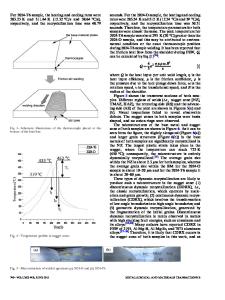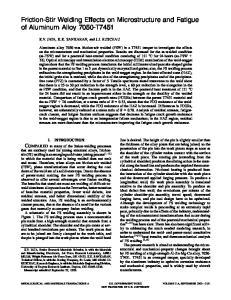Features of Forming a Structure of the Copper-Zinc Alloy Coating on the Aluminum Alloy Surface by Friction Stir Processi
- PDF / 5,796,859 Bytes
- 7 Pages / 595.276 x 790.866 pts Page_size
- 47 Downloads / 345 Views
FEATURES OF FORMING A STRUCTURE OF THE COPPER-ZINC ALLOY COATING ON THE ALUMINUM ALLOY SURFACE BY FRICTION STIR PROCESSING A. V. Gusarova, A. V. Chumaevskii, A. P. Zykova, D. A. Gur’yanov, K. N. Kalashnikov, and T. A. Kalashnikova
UDC 539.388.2
The structure of samples of the C27400 copper alloy coatings on the AA5056 aluminum alloy surface, produced by friction stir processing of a rolled sheet package is studied. The regularities of the structure formation at deformation-initiated mixing of Al–(Cu, Zn) system components are elucidated. Intensive diffusion and mechanical mixing of the Al–(Cu, Zn) system components is revealed, resulting in the formation of a complex structure of the stir zone on the macrolevel. It is established that during the formation of the structural-phase composition of the coating, the solid aluminum solutions are formed in copper by zinc extrusion from the solid solution together with complex solid solutions and intermetallic phases by zinc diffusion into the aluminum lattice. Keywords: friction stir processing, polymetallic materials, functionally graded materials, copper alloys, aluminum alloys, coating.
INTRODUCTION Production of tribotechnical materials for aircraft and spacecraft industry is inevitably associated with attempts to reduce the volumetric weight of the products. In this case, the materials most widely used for sliding bearings are various copper alloys possessing high density. One of the ways to solve this problem is the formation of tribological coatings on sufficiently light and strong materials such as titanium or aluminum alloys. The main disadvantage of modern methods of coating production is a sharp interface between the coating and the substrate and, as a consequence, their low adhesion. One of the methods of forming hardened surface layers with a smooth gradient from the coating to the substrate is the friction stir processing [1–6]. By its nature, the method is based on the phenomenon of adhesive friction [7–12] and is similar to the friction stir welding [13]. This method is mainly used to fabricate coatings in which powder particles of the second phase are distributed over the surface layer of the material by filling specially formed holes or grooves [14–17]. This technology has a number of disadvantages from the practical point of view because of a large number of accompanying operations before coating formation. A part of studies is based on the formation of copper or copper alloy coatings on the surface layer of the aluminum alloy by friction stir processing of copper or copper alloy sheet packages of various thicknesses [18, 19]. This process is accompanied by forming a complex structure from solid solutions and intermetallic phases in the coatings due to excessive heat generation and deterioration of the coating structure with excessive formation of continuous intermetallic phase layers. One of the reasons for this phenomenon is high heat generation under conditions of mutual diffusion of aluminum and copper used to obtain intermetallic compounds [20].
Data Loading...











